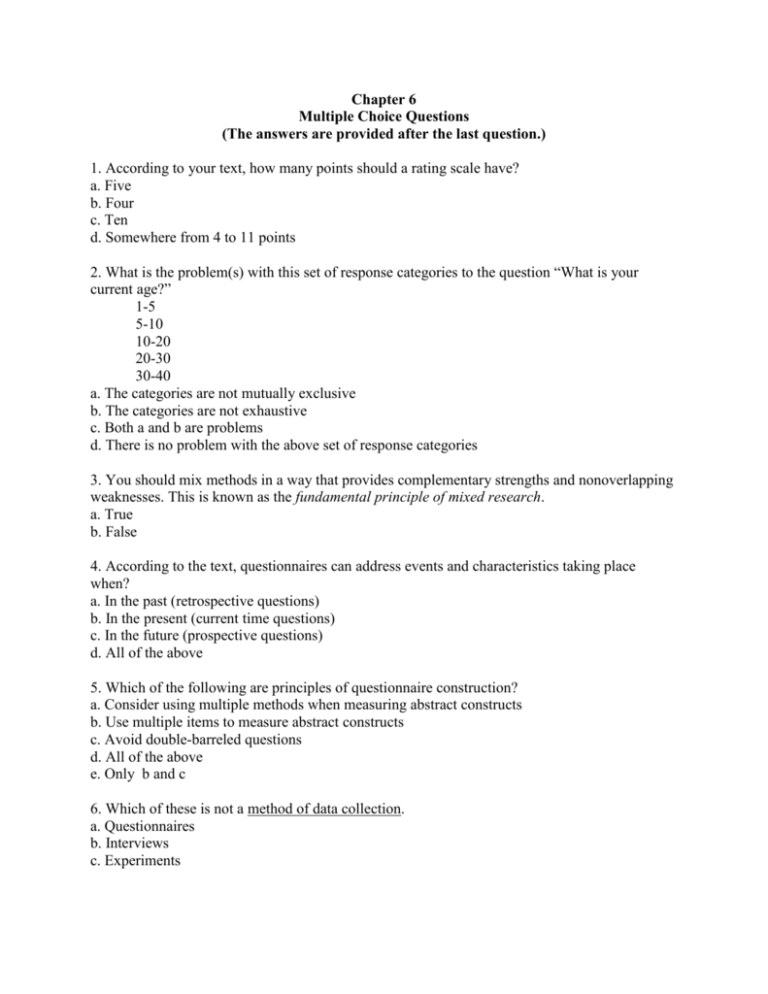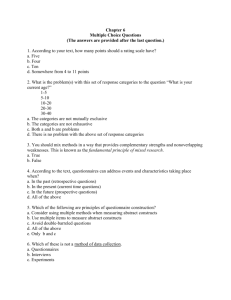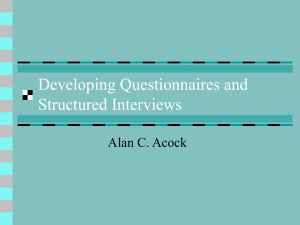MC6.DOC - University of South Alabama
advertisement

Chapter 6 Multiple Choice Questions (The answers are provided after the last question.) 1. According to your text, how many points should a rating scale have? a. Five b. Four c. Ten d. Somewhere from 4 to 11 points 2. What is the problem(s) with this set of response categories to the question “What is your current age?” 1-5 5-10 10-20 20-30 30-40 a. The categories are not mutually exclusive b. The categories are not exhaustive c. Both a and b are problems d. There is no problem with the above set of response categories 3. You should mix methods in a way that provides complementary strengths and nonoverlapping weaknesses. This is known as the fundamental principle of mixed research. a. True b. False 4. According to the text, questionnaires can address events and characteristics taking place when? a. In the past (retrospective questions) b. In the present (current time questions) c. In the future (prospective questions) d. All of the above 5. Which of the following are principles of questionnaire construction? a. Consider using multiple methods when measuring abstract constructs b. Use multiple items to measure abstract constructs c. Avoid double-barreled questions d. All of the above e. Only b and c 6. Which of these is not a method of data collection. a. Questionnaires b. Interviews c. Experiments d. Observations 7. Secondary/existing data may include which of the following? a. Official documents b. Personal documents c. Archived research data d. All of the above 8. An item that directs participants to different follow-up questions depending on their response is called a ____________. a. Response set b. Probe c. Semantic differential d. Contingency question 9. Which of the following terms best describes data that were originally collected at an earlier time by a different person for a different purpose? a. Primary data b. Secondary data c. Experimental data d. Field notes 10. Researchers use both open-ended and closed-ended questions to collect data. Which of the following statements is true? a. Open-ended questions directly provide quantitative data based on the researcher’s predetermined response categories b. Closed-ended questions provide quantitative data in the participant’s own words c. Open-ended questions provide qualitative data in the participant’s own words d. Closed-ended questions directly provide qualitative data in the participants’ own words 11. Open-ended questions provide primarily ______ data. a. Confirmatory data b. Qualitative data c. Predictive data d. None of the above 12. Which of the following is true concerning observation? a. It takes less time than self-report approaches b. It costs less money than self-report approaches c. It is often not possible to determine exactly why the people behave as they do d. All of the above 13. Qualitative observation is usually done for exploratory purposes; it is also called ___________ observation. a. Structured b. Naturalistic c. Complete d. Probed 14. As discussed in chapter 6, when constructing a questionnaire it is important to do each of the following except ______. a. Use "leading" or "loaded" questions b. Use natural language c. Understand your research participants d. Pilot your test questionnaire 15. Another name for a Likert Scale is a(n): a. Interview protocol b. Event sampling c. Summated rating scale d. Ranking 16. Which of the following is not one of the six major methods of data collection that are used by educational researchers? a. Observation b. Interviews c. Questionnaires d. Checklists 17. The type of interview in which the specific topics are decided in advance but the sequence and wording can be modified during the interview is called: a. The interview guide approach b. The informal conversational interview c. A closed quantitative interview d. The standardized open-ended interview 18. Which one of the following in not a major method of data collection: a. Questionnaires b. Interviews c. Secondary data d. Focus groups e. All of the above are methods of data collection 19. A question during an interview such as “Why do you feel that way?” is known as a: a. Probe b. Filter question c. Response d. Pilot 20. A census taker often collects data through which of the following? a. Standardized tests b. Interviews c. Secondary data d. Observations 21. The researcher has secretly placed him or herself (as a member) in the group that is being studied. This researcher may be which of the following? a. A complete participant b. An observer-as-participant c. A participant-as-observer d. None of the above 22. Which of the following is not a major method of data collection? a. Questionnaires b. Focus groups c. Correlational method d. Secondary data 23. Which type of interview allows the questions to emerge from the immediate context or course of things? a. Interview guide approach b. Informal conversational interview c. Closed quantitative interview d. Standardized open-ended interview 24. When conducting an interview, asking "Anything else?, What do you mean?, Why do you feel that way?," etc, are all forms of: a. Contingency questions b. Probes c. Protocols d. Response categories 25. When constructing a questionnaire, there are 15 principles to which you should adhere. Which of the following is not one of those principles? a. Do not use "leading" or "loaded" questions b. Avoid double-barreled questions c. Avoid double negatives d. Avoid using multiple items to measure a single construct Answers: 1. d 2. c 3. a 4. d 5. d 6. c 7. d 8. d 9. b 10. c 11. b 12. c 13. b 14. a 15. c 16. d 17. a 18. e 19. a 20. b 21. a 22. c 23. b 24. b 25. d








